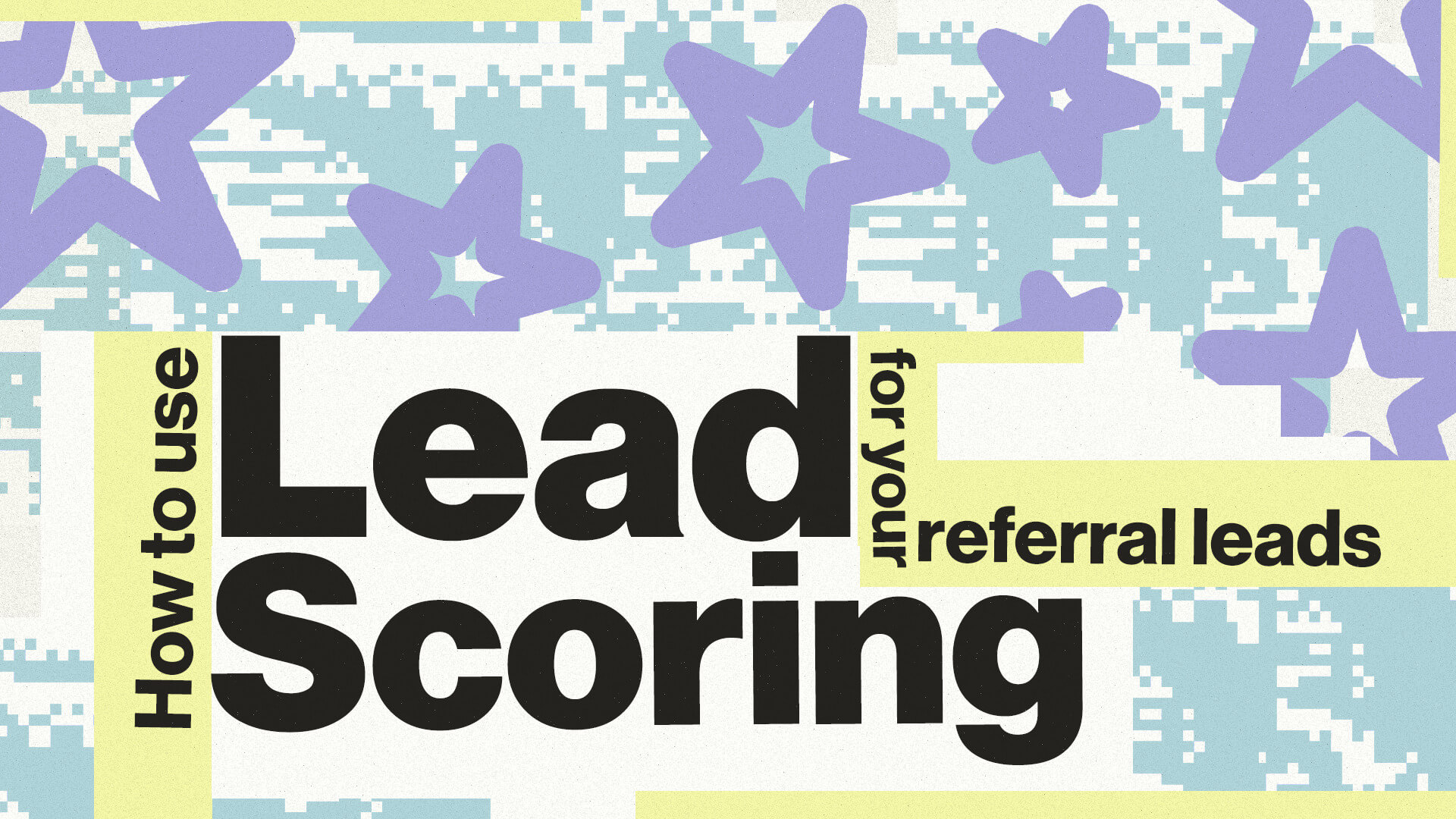Alright, so you wanted a five-fold increase in your revenue this year.
You executed multiple marketing strategies and gathered a significant number of leads—what a victory!
But somewhere down there, your leads are still just that—leads, not paying customers. While your marketing team tirelessly promotes your offerings, the sales team struggles to convert those opportunities into closed deals.
You got frustrated, discouraged, and disheartened. We completely understand.
Good news, though; this can be turned around!
This is where lead scoring comes in.
Businesses leveraging lead scoring have seen a remarkable 79% boost in ROI in lead conversion compared to those that don’t. That’s exactly the kind of result you’re aiming for, right?
If so, continue diving in to uncover how to use it to elevate your business performance.
Understanding Lead Scoring: Breaking Down the Basics
What is Lead Scoring?
When we zero in on the term lead scoring, it’s easy to think of it as simply assigning scores or values to potential leads. While that idea is on the right track, it’s time to demystify this too-simplified definition.
Lead scoring is a strategic method for ranking each lead based on their potential and commitment to become part of your business’ success.
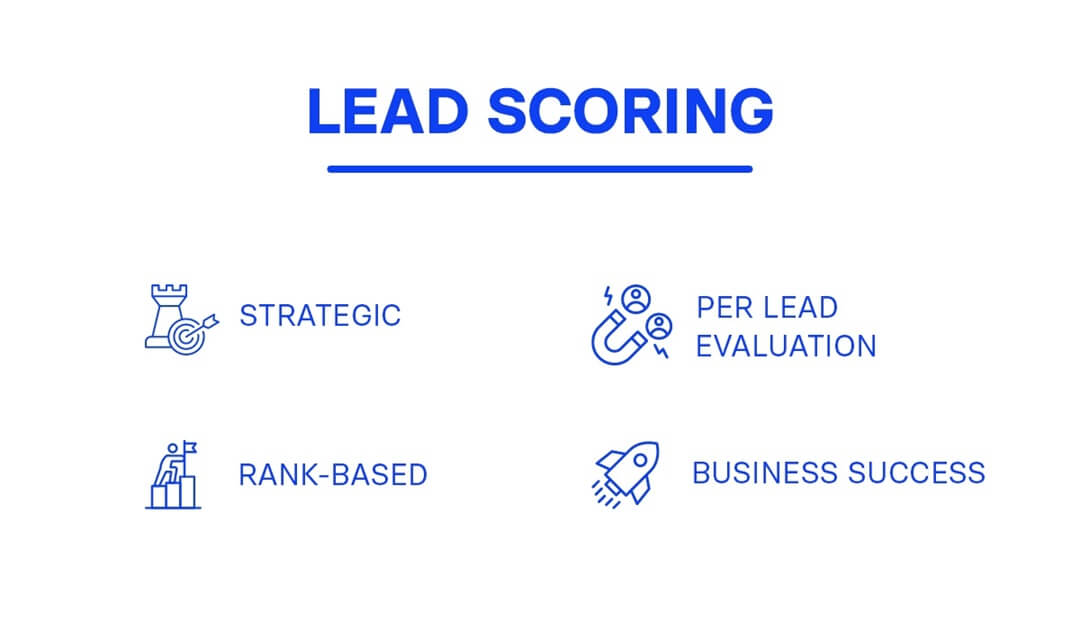
Let’s unpack this definition.
- Strategic Method. Lead scoring is a systematic approach that businesses can adopt for lead management. Yes, it’s a system and a strategic one! This approach involves filtering a pool of leads and prioritizing them according to their likelihood of converting into paying customers.
Moreover, it includes ongoing monitoring, assessment, and fine-tuning to ensure it remains effective and aligned with changing market conditions.
- Rank-Based. Since lead scoring is systematic, then, it is not intuitive. You are not basing your decisions on gut feelings. Rather, businesses work on well-thought-out indicators tailored to their brand and target outcomes.
These indicators will be used to assign values or scores to leads. Their interactions with your brand, their demographics, and the behavioral patterns that they exhibit are just some of the usual indicators being considered.
- Evaluates Each Lead. To maximize its potential, you should score each lead and rank them individually. The truth is, not all leads are created equal so you need to assess each,
Labor intensive? Yes.
But it provides a quantitative measure of each lead’s quality, which will later improve the sales team’s efficiency. Leveraging automation tools can streamline this process significantly. We’ll explore these in detail shortly since we want you to work smarter, not harder.
- Goal-Oriented. Business success is your goal, and lead scoring offers support for achieving it in the form of ROI, lifetime values, and lower acquisition costs, among others.
It is important to recognize that each business may have different KPIs. But despite these differences, the core idea remains the same: it’s a system for effectively achieving your desired business outcomes.
Why does lead scoring work?
It’s straightforward. Assigning an objective point value to new prospects makes it incredibly easy for salespeople to know where to invest time, effort, and finances.
It turns you away from hit-and-miss sales and marketing.
Benefits of Using Lead Scoring in Combination with Referral Marketing
The primary purpose of lead scoring is to supercharge the efficiency and effectiveness of your sales and marketing, eventually achieving your desired business outcomes. It is like the strategic GPS that guides you toward high-value leads.
Referral marketing, on the other hand, is one of the best ways to gain new leads for your business. It isn’t just a fancy term—it’s a powerhouse strategy where businesses get their customers to do the marketing.
Instead of just running ads, you’re encouraging your happy customers to promote and sing praises about your brand. Often, this involves sweetening the deal with incentives or rewards for those successful referrals.
But have you ever experienced gaining tons of new referrals but still the conversion rate from referral to customer is too low?
If you want to optimize your sales gain, then you must use lead scoring in referral marketing, and here’s why:
- Drives revenue growth. Lead scoring can pinpoint high-potential prospects during the early part of the sales cycle. By engaging with them, you get a clear picture of who among them is most likely to convert. This early identification means you can engage with your hot leads immediately, increasing your chances of turning them into paying customers.
A whopping 68% of highly effective marketers considered lead scoring the top contributor to their revenue increase.
Meanwhile, a comprehensive study conducted by Eloqua revealed that, on average, the adoption of lead-scoring systems can boost deal closing rates by 30% and increase company revenue by 18%.
We told you, it’s a game-changer!
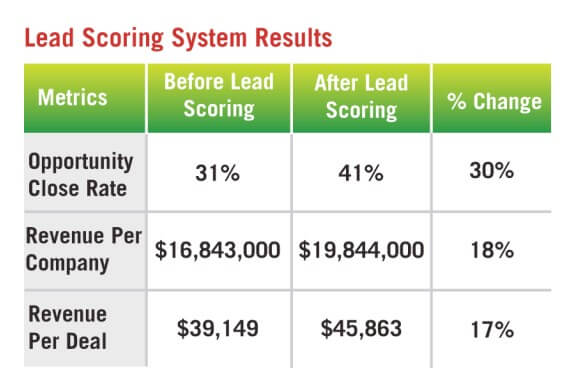
Source: Eloqua
- Better Sales and Marketing Strategies. Lead scoring lets you customize your marketing and sales strategies to match the needs and interests of different referral segments.
While you want to ditch cold leads and prioritize hot leads, you must also nurture warm leads to increase sales opportunities. They all require different strategies!
This customization enhances engagement, improves conversion rates, and builds stronger relationships with your leads. When you know what makes each lead think and tick, you can build connections that lead to sales.
Some interesting stats, as compiled by HubSpot, revealed that:
- Nurtured leads result in purchases that are 47% larger than non-nurtured ones.
- Nurturing emails generates 4-10x higher response rates.
- Personalized emails increase click rates by 14% and conversion rates by 10%.
- Efficiency = Save Time and Money. Lead scoring does the heavy lifting of filtering leads, thereby significantly cutting both time and costs. Optimizing resource allocation eliminates unnecessary expenses associated with low-potential channels or referrals that fall below your scoring threshold.
Every dollar and time spent becomes an investment in real results rather than a gamble on uncertain prospects.
Not every lead looks good at first glance, which is why implementing a robust lead scoring system is essential—it transforms your approach and maximizes the returns on your marketing efforts.
- Prioritize Top Leads First. Remember the age-old Pareto Principle that states 80% of the outcome comes from 20% of the sources?
If 80% of your revenue comes from 20% of your prospects, it would make sense to find these 20% and focus on them first, right?
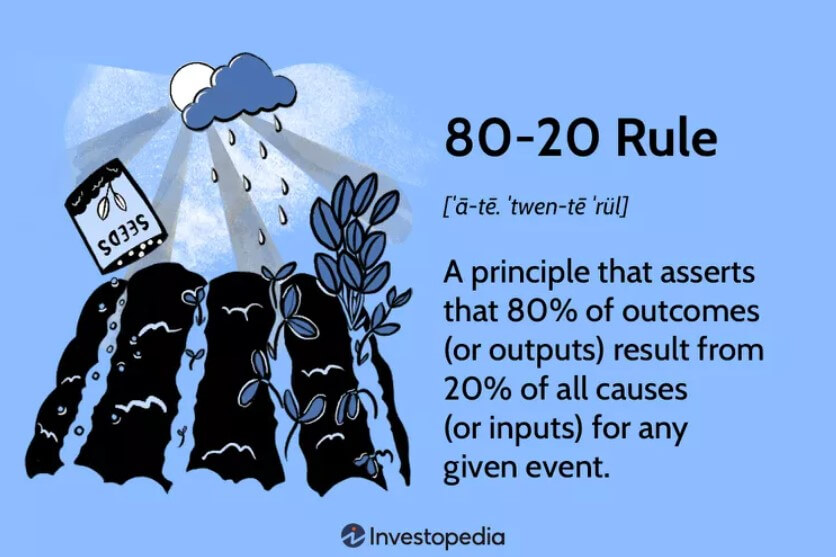
Based on findings from a DemandGen Report, businesses using lead scoring in their Lead Management Systems could see a whopping 70% boost in ROI compared to those skipping lead scoring.
Once you’ve fully followed up on the hottest leads, you can move further down the line. It’s good business sense.
- Sales and Marketing Team Collaboration and Alignment. Sales and marketing must collaborate closely to guarantee that high-quality leads flow into the pipeline. By leveraging data-driven insights about lead quality, marketers can gain a clearer picture of their audience and identify the characteristics that define high-scoring leads.
This understanding enables teams to make informed adjustments to their strategies, ensuring they continue to attract leads that convert effectively for the sales team.
Combining referral marketing with lead scoring isn’t just about converting referrals. It’s about generating the right leads—ones that are primed and ready to become your next big success story.
Unveiling Lead Scoring Techniques
Despite these benefits and opportunities, it’s quite astonishing to discover that a staggering 64% of companies, especially in the B2B marketing sector, have yet to leverage the power of lead scoring because their sales and marketing teams don’t agree.
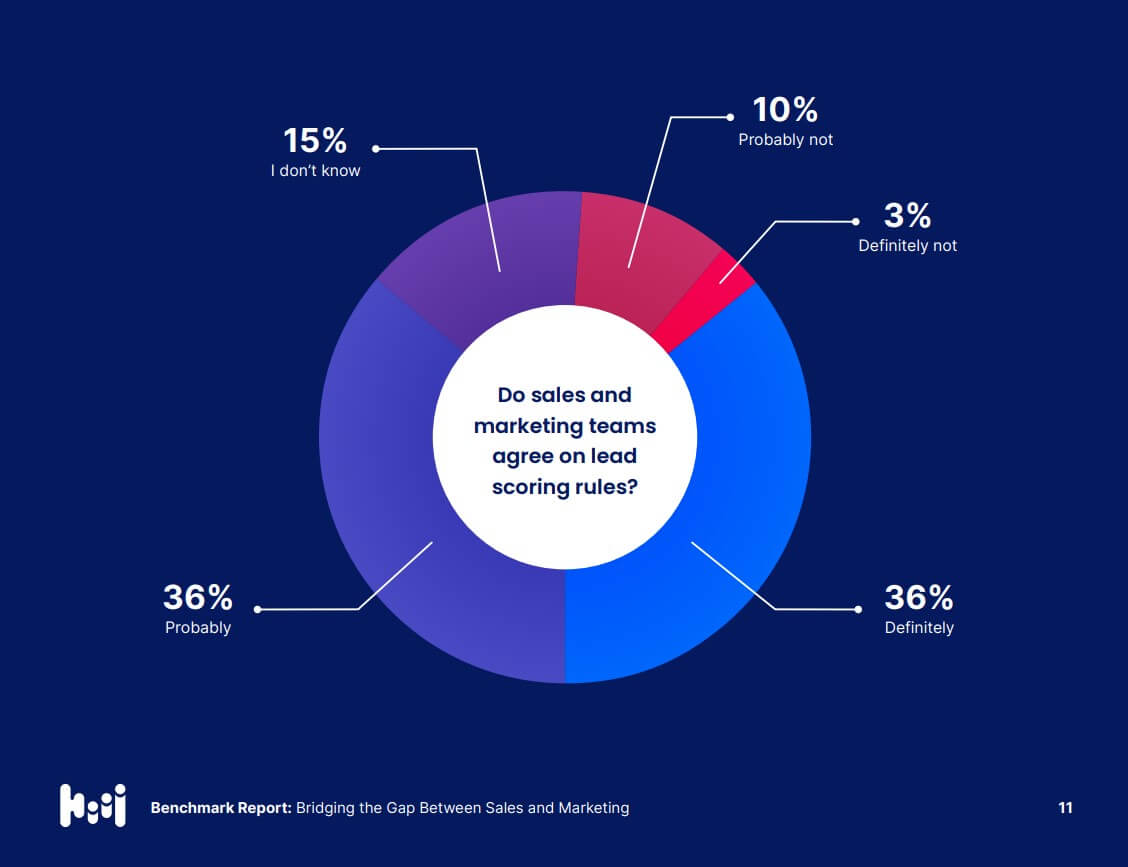
Source: DemandScience
Even more perplexing is the fact that 27% of these businesses have no intention of adopting this crucial strategy.
This oversight not only compromises their ability to prioritize high-quality leads but also hampers their overall marketing efficiency.
With the right strategies in place, businesses can shift away from daunting statistics and toward a more efficient, lead-driven approach. Let’s explore these here.
Explicit Scoring
Think of this as your lead scoring blueprint. The data gives you a clear insight into who your leads are and how likely they are to contribute to your sales.
In explicit scoring, you’re assigning points based on tangible data, often demographic information about the lead such as:
- Job title
- Company size
- Industry
- Budget
Examples:
#1: A CEO of a large enterprise might receive a higher lead score than a junior employee, simply because they wield more influence and budget.
#2: A manager working in a company with an employee size of 200 to 1,000 can have a higher lead score than the director of a company with 2 to 5 employees only.
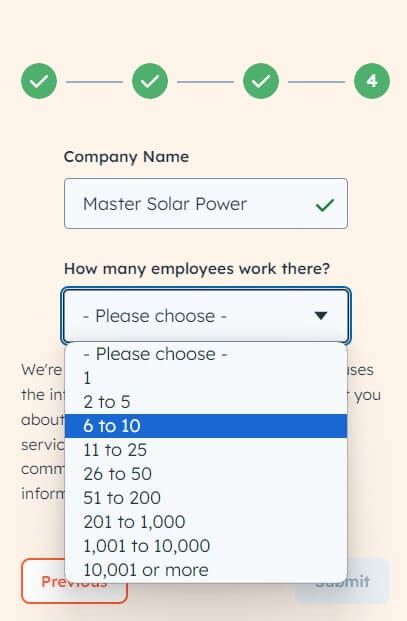
#3: A company operating in the software industry might prioritize leads from similar sectors due to their higher potential for conversion and alignment with the business’s target market.
Here are some scoring combinations employing explicit techniques:
1. BANT Scoring
This time-honored scoring method centers around four key elements: Budget, Authority or the individual responsible for purchasing decisions, Needs (in relation to your brand’s product or service), and the Time frame for purchase.
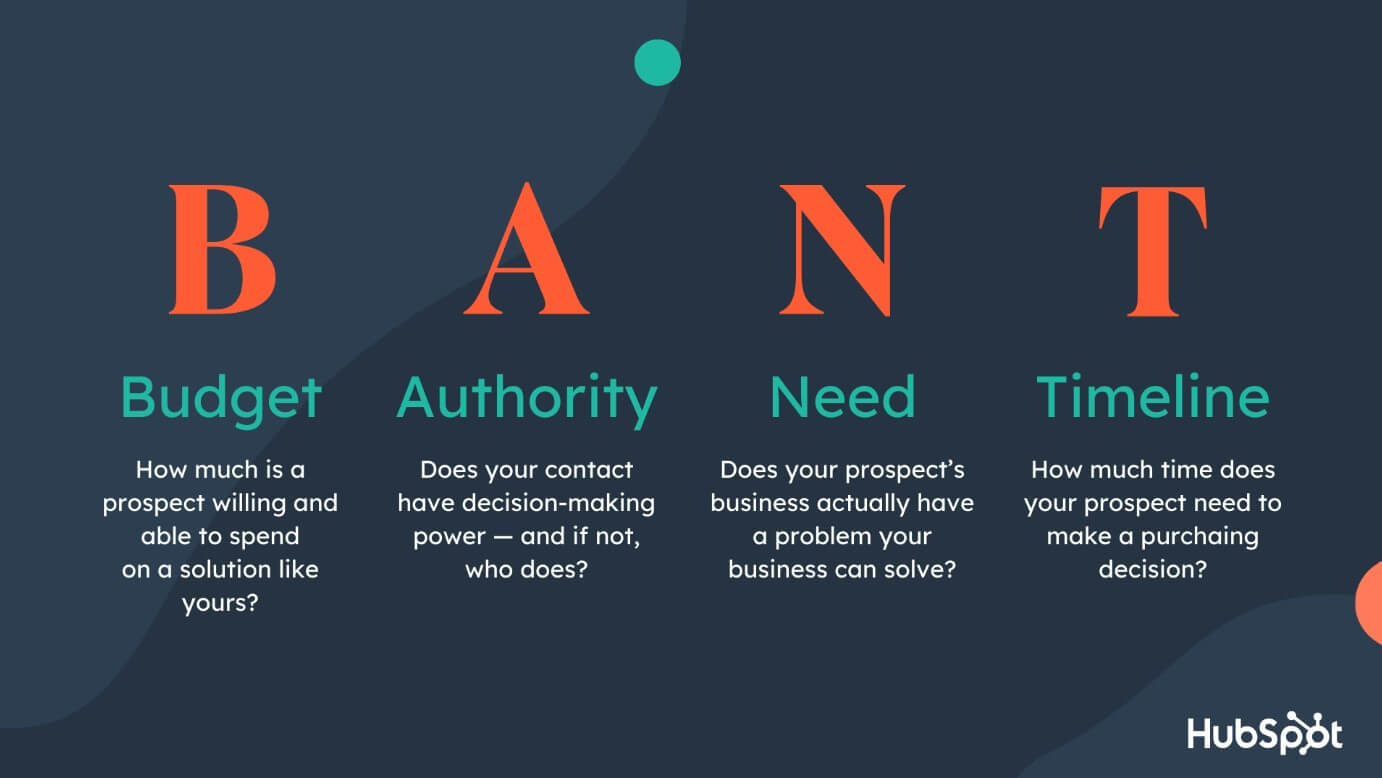
Source: HubSpot
2. Firmographic Scoring
This approach, particularly beneficial in B2B contexts, leverages crucial data points such as company size, industry sector, geographical location, and revenue.
3. ANUM Scoring
This framework prioritizes the Authority in purchasing decisions, the Need of the lead, the Urgency of the purchase, and the Money or budget considerations involved.
Implicit Scoring
Now, let’s talk about implicit scoring, where intent can be read between the lines.
The idea behind implicit scoring is that people who are more likely to buy your product or services will show certain behaviors reflecting their intent to purchase.
This method focuses on assessing lead behavior and engagement patterns, such as:
- Website visits: How often do they check out your website?
- Content downloads: Are they consuming your resources or information?
- Email opens: Are they engaged with your email campaigns?
- Referral Status: Were they referred to your platform by a customer?
- Webinar attendance: Are they tuning into your live events?
Analyzing or tracking a prospect’s online behavior can provide powerful insights into how likely they are to purchase.
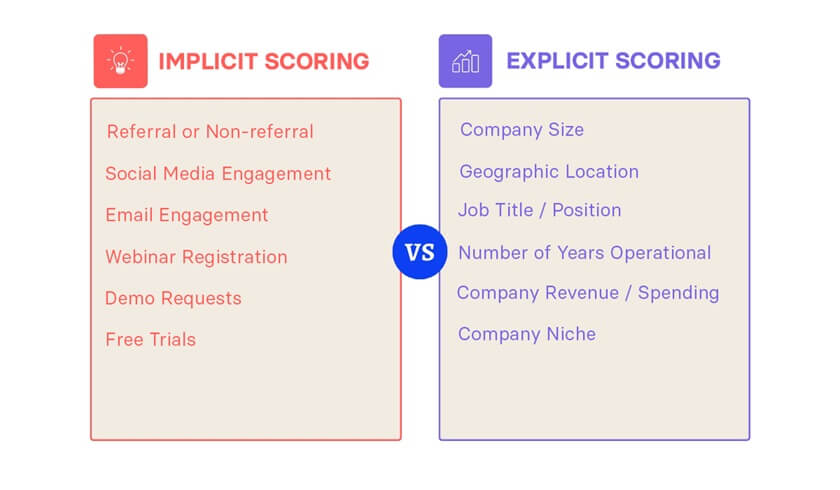
Examples:
#1: A lead who frequently visits pricing pages or watches product demo videos demonstrates a strong intent to purchase, warranting a higher lead score.
#2: Multiple interactions with content such as whitepapers or case studies indicate a deeper interest in the product or service, signaling readiness for further engagement.
#3: In an e-commerce setting, a lead who abandons their shopping cart multiple times but returns to review pricing details exhibits significant interest and should be prioritized in lead nurturing and remarketing efforts.
Here’s the kicker: magic happens when you combine explicit and implicit scoring.
Don’t settle for just one approach—combine them to be able to create a powerful lead scoring model. This hybrid method allows you to identify leads who show both the right actions and hold the right attributes.
It’s more complicated, sure, but it’s also more effective, letting you focus on leads with the highest conversion potential.
Predictive Scoring
Traditional lead scoring has long relied on both implicit and explicit metrics, but let’s be honest—this manual approach can be more of a chore than a charm.
Setting up these traditional models involves significant hands-on effort, from inputting data to fine-tuning for optimal performance. For many businesses, this can feel overwhelming, drawing away valuable time and resources.
The real question is: how can we streamline this process, reduce the potential for human error, and make lead scoring not just efficient but truly effective?
This is where predictive lead scoring can come to the rescue.
Predictive lead scoring is currently the crystal ball of lead scoring and the way of the future. It uses advanced analytics and machine learning algorithms to forecast lead quality based on historical data and predictive analytics.
Connected Customer Relationship Management (CRM) and marketing automation systems, including your referral marketing software, supply the necessary internal data for these algorithms.
This predictive model can leverage various data points, such as website behavior, demographics, and purchase history, much like traditional lead scoring. However, it offers enhanced adaptability and deeper insight, allowing for a more nuanced understanding of potential leads.
According to insights from 6sense, nearly 450,000 companies, mostly in the USA, have embraced predictive lead scoring tools, with most having between 1 and 49 employees.
This statistic underscores the growing reliance on predictive lead scoring as a dependable strategy for improving sales effectiveness and refining marketing efforts across diverse sectors.
From Data to Decisions: Developing an Effective Lead Scoring Model
Companies may use different lead-scoring systems based on their goals, but the basic principles of lead-scoring remain consistent.
Let’s now examine how you can craft a lead-scoring model that is as sharp as a tack.
Step 1 – Identify and Understand Your Target Market
Before you begin scoring leads, it’s essential to have a clear understanding of who you’re scoring. Knowing your ideal customer profile is crucial to evaluating their quality accurately. Grasping the nuances of your target market forms the foundation for creating an efficient lead scoring model.
Get ready to get under their skin.
Key questions to consider to be able to understand your target market include:
- What is the identity of my company and what problems does it solve?
- Who’s feeling the pain from those problems?
- Who has bought your products and/or services, who has not, and why?
- Which marketing language, messages, style, audience, and channels resonate most effectively with your target audience?
But don’t stop there. Use these guide questions to dig deeper:
- What are the demographics and characteristics of your ideal customers?
- What do they truly want?
- Where are they coming from?
- When and how do they typically engage with us throughout the buying journey?
- Why do prospects choose your solution over others?
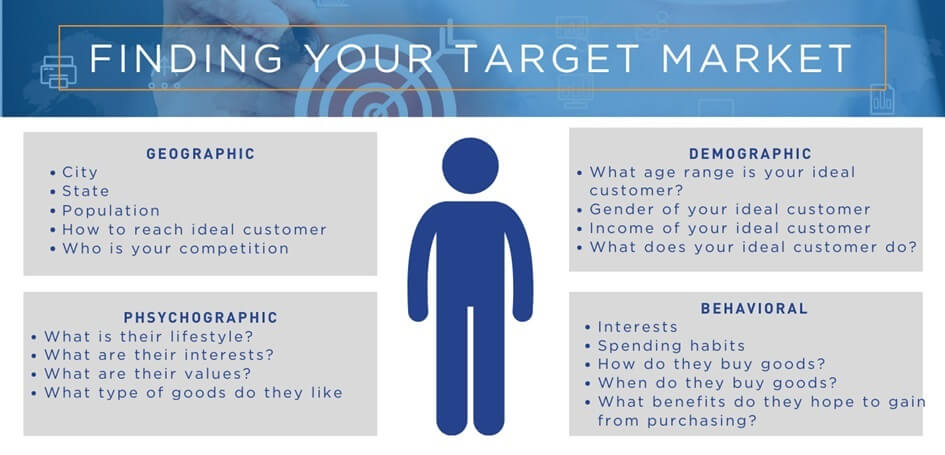
Image source: SpiritBoxNation
Finally, it’s essential to analyze historical customer data to pinpoint the key characteristics of your ideal customers. This is particularly important when employing a predictive lead scoring model, as past data plays a crucial role in assessing lead quality effectively.
Step 2 – Create Your Point System
Now that you know your ideal customer, let’s build your scoring system.
Developing a structured point system involves defining criteria and assigning weights based on their impact on lead quality. Imagine that you’re creating a recipe, and you need to get the specific weight of each ingredient.
Here’s how you can mix it:
- Demographic Factors: Assign points based on attributes such as job title, industry, company size, and location. These data, which can easily be gathered through research or online forms, are important but represent just the tip of the iceberg.
- Behavioral Indicators: Track how leads interact with your brand. Look at interactions such as website visits, form submissions, and social media engagement to get a glimpse into their true intent. These indicators can be tracked by the CRM system, your best friend, giving the data to score leads accurately. This system will be discussed in detail later.
- Engagement Level: Engagement is a powerful indicator of interest. Higher levels of engagement, such as attending webinars or requesting product demos, merit higher lead scores.
- Lead Source: Where did the leads come from? Organic search, paid ads, referrals? This helps you gauge the lead’s quality and relevance.
Referral leads typically receive a high score due to the trust factor involved; they come from satisfied customers or trusted contacts who vouch for your services.
This pre-existing trust often leads to higher conversion rates, as these leads are more likely to engage and make decisions based on positive recommendations. Additionally, referral leads tend to have a better understanding of your offerings, resulting in a smoother sales process and a more meaningful relationship from the outset.
- Buyer’s Journey Stage: Different stages in the buyer’s journey require different levels of engagement. A lead who has just discovered your brand may not be as qualified as someone who is actively evaluating solutions.
- Fit with Ideal Customer Profile: This is where your understanding of your target market comes into play. Assign points based on how well a lead matches the profile you have established.
- Negative Signals: Of course, not every action is a sure thumbs-up. Deduct points for actions indicating disinterest or non-alignment with your offering, such as unsubscribing from emails or bouncing from your website.
Lowering lead scores can help accurately measure the lead’s current conversion probability. Deduct scores accordingly, but always watch for your leads’ signs of renewed interest that could bump their scores back up.
If leads show more frequent opens and clicks, it might suggest that they’re ready to buy, this should trigger a sales follow-up.
Here’s an examples of a lead scoring system based on the aforementioned indicators:
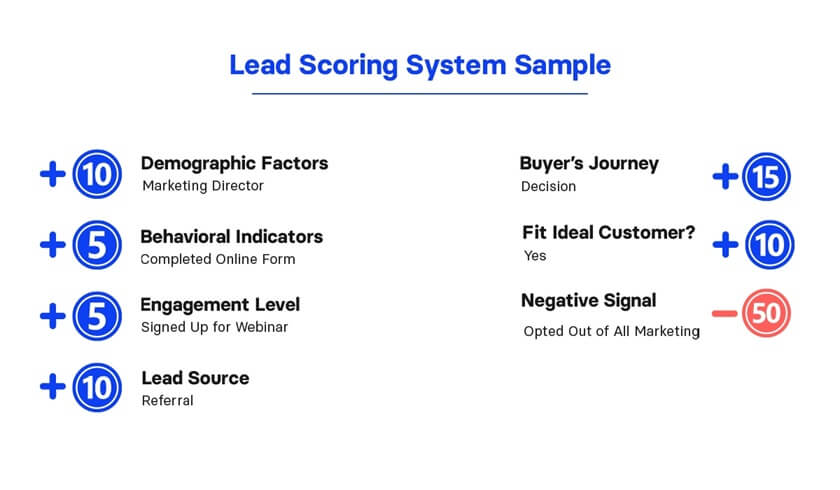
Assigning points for specific actions allows businesses to prioritize leads effectively.
For instance, downloading a whitepaper might contribute +10 points, while unsubscribing from emails could result in a deduction of -20 points.
Step 3 – Assign Point Categories
Next, decide how many points make a lead hot, warm, or cold:
- How many points does someone need to be considered a top-priority lead?
- How many points are required for a lead to be considered a Marketing Qualified Lead (MQL)?
- How many points indicate that a lead should be deprioritized or left behind?
The sales and marketing team should determine these thresholds through a series of tests. These thresholds help you prioritize your follow-ups and focus your efforts on where they matter most.
Note: An MQL is a prospective customer who has shown interest in your product or service but hasn’t yet engaged with your sales team.
We’ll talk more about qualifying leads in a bit.
Step 4 – Automate Lead Scores using CRM Software
Here’s where it gets more exciting: integrating your lead scoring model with the CRM software.
This software streamlines your lead scoring process and keeps the marketing and sales teams in sync by providing the following:
- Real-time Updates: CRM systems can automatically update lead scores based on new interactions or changes in lead behavior. This ensures that you’re working with the freshest info.
- Notification Alerts: Automated alerts notify teams when leads hit key scoring thresholds, enabling prompt follow-up and personalized outreach.
- Visualization and Reporting: Visual dashboards and reports provide a clear view of your lead scoring effectiveness, allowing you to tweak strategies, and boost conversion rates.
Once you have entered the lead-scoring criteria into the CRM software, it’s now time for CRM to do its job. It will automatically assign scores to the leads and track any changes in their scores.
For instance, if a lead has been imported from your referral program software, you can immediately assign it high points. The lead’s engagement with your follow-up email campaigns can be added to its score.
Examples of CRM software with lead scoring are Zoho and HubSpot.
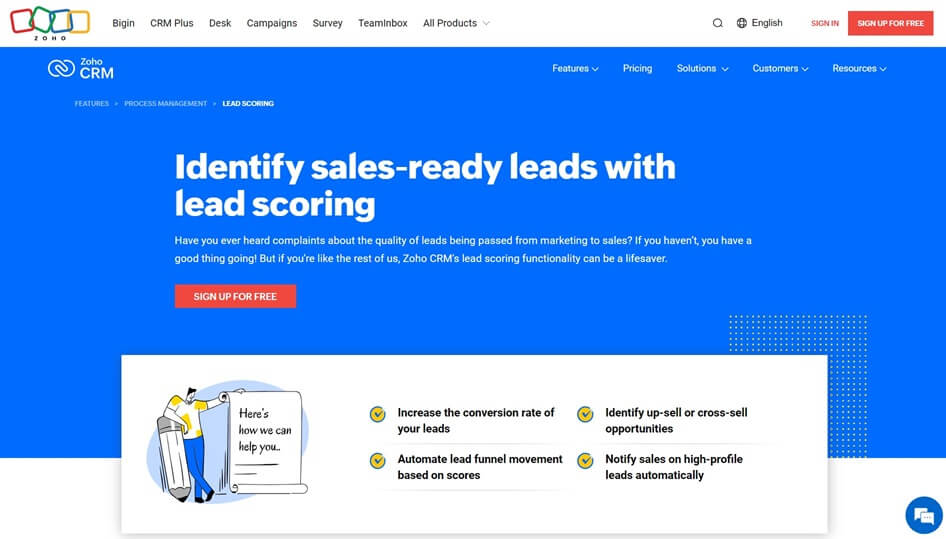
Your CRM can also employ predictive scoring through an algorithm based on the criteria you set to automatically identify the leads with the highest conversion probability. HubSpot has this feature.
Another plus point of predictive scoring through the CRM software is that the longer you use it, the smarter it gets, consequently providing you with more accurate data.
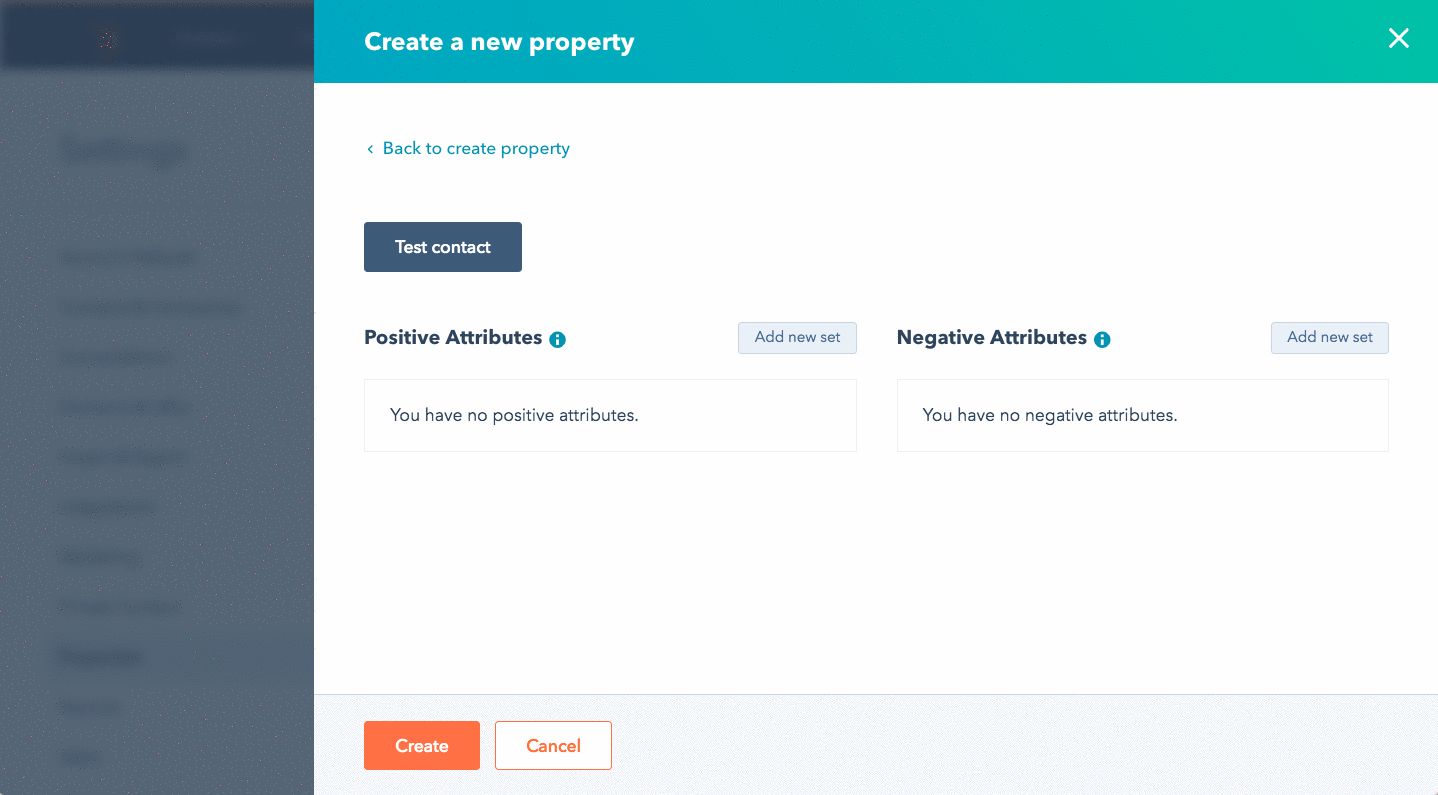
Step 5 – Continue Monitoring and Optimization
Lead scoring is not a stagnant process but is a dynamic one that requires ongoing monitoring and optimization, as well as continuous refinement, to remain effective:
- Performance Analysis: Regularly analyze and review key performance metrics, such as lead conversion rates and ROI, to evaluate the accuracy and impact of your lead scoring model.
- Feedback Loop: Gather input from sales teams on the quality of leads and the success of conversions to enhance scoring criteria and adapt to changing market conditions. Additionally, it is essential to seek feedback from customers and leads through direct outreach, net promoter scoring, and surveys.
- Experiment. Take the opportunity to engage directly with various businesses’ landing pages and navigate through their lead management systems. Observe what responses are effective and identify the actions you took that elicited those responses.
- Iterative Refinement: Continuously update and refine your lead scoring model based on insights gained from data analysis and team feedback, ensuring alignment with changing business objectives and market conditions.
How to Qualify and Prioritize Your Best Prospects
Once you have established your lead scoring system and assigned scores to your prospects based on the data that you have collected, it is now time to weave your results into your business process.
Here’s where the magic happens: segment your leads based on their scores.
From there, you can design strategies to engage them, each one designed to meet their unique needs and preferences. This is not just a process – it’s your roadmap to turning scores into sales.
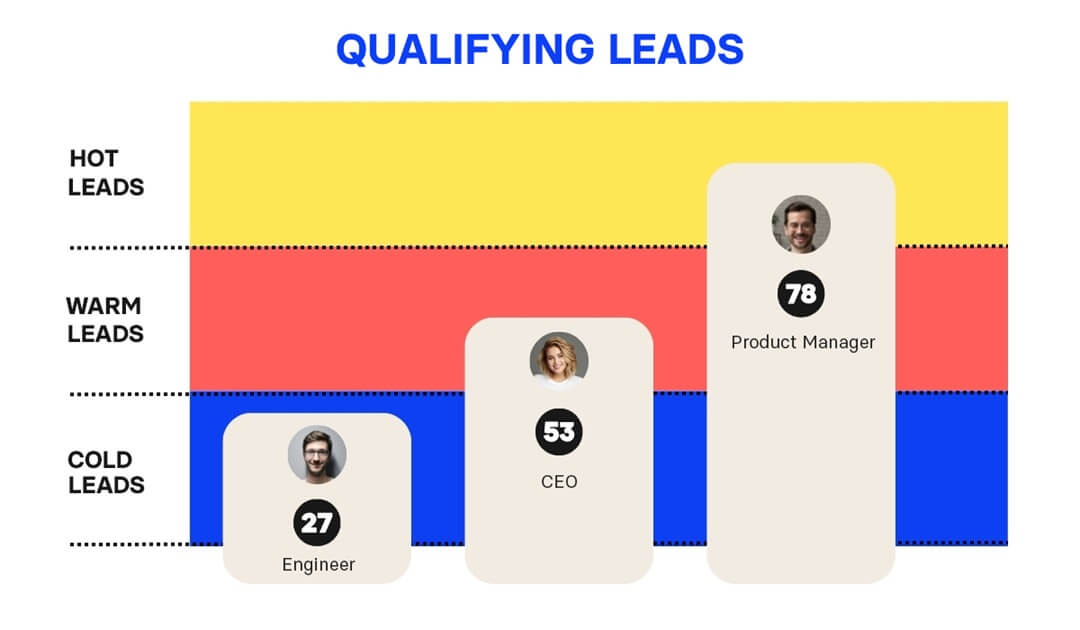
The High Scorers: The Hot Lead to Prioritize
When your best leads wave the flag and say, “We are ready!” roll out the red carpet for them.
These are the things to keep in mind to ensure that your top leads will not slip through the cracks:
- Have a personalized outreach strategy. Send them tailored emails addressing their needs. You can mention the recent interactions with your business and how you can solve their problems.
- Always prioritize follow-ups. Leads with high scores deserve a quick response. Always coordinate with the best salespeople in your company who will follow up and seal the deal.
- Why not make them feel extra special? Offer them exclusive deals early access to new features and promos. This way, you can make them feel special and valued.
Your Referred Leads as Hot Leads
Think back to our previous conversation about referral marketing—it’s more than just a tactic; it’s a powerful strategy! Your referrals aren’t just ordinary leads; they’re hot and eager prospects hand-delivered to you by satisfied customers.
In most cases, they are called qualified leads.
Unlike cold leads, referred leads have already been vetted by a mutual connection, which enhances their credibility and makes them more receptive to engagement.
As a result, businesses often prioritize these leads in their sales process, leveraging the existing relationship to facilitate deeper conversations and ultimately drive conversions.
Data speaks volumes when it comes to its power. Referred leads boast four times better conversion rate compared to other lead generation channels, which is impressive on its own.
Additionally, these leads offer a 16% higher lifetime value.
If these statistics don’t convince you of the undeniable value of referred leads as hot leads, then it’s hard to imagine what will!
When someone vouches for you, it carries a seal of trust, opening the door to new opportunities. This personal touch not only makes them more receptive but also sets the stage for meaningful connections that can seamlessly transition into loyal clients.
The Mid-Scorers: Warm But with Potential
These are your leads that show interest but are not yet there. They have engaged with you in several channels, but they need nurturing.
But how can you nurture them?
- Provide them with educational content that addresses their pain points or problems.
- Invite them to join webinars or live demos to see your product in action.
- Keep your communication with them open. Do regular, but not overwhelming, follow-ups. Show them how others have benefitted from the solutions you offer.
But here’s the deal. Nurturing requires customization.
Effective nurturing campaigns are not universally applicable; they require careful customization to align with the specific stage of the sales cycle and the unique traits of each lead. By strategically developing your nurture paths that reflect these factors, you can significantly enhance engagement and conversion rates.
The Low Scorers: The Cold Contacts
These are your leads who, maybe, have only visited your website once or twice. They’re not ready to purchase yet, but that doesn’t mean that they never will. So how can you turn them into high scoring leads?
- Set up automated email sequences to keep them engaged over time. Provide success stories that they can relate to.
- Connect with them on social media and share content that might interest them.
- Provide updates about your product or industry news. Keep your business on their radar without being too demanding.
However, among the three segments, this is where you should least prioritize your resources the most. Implementing automation can significantly enhance the effectiveness of the tips outlined above while reducing costs.
Remember that in segmenting and qualifying leads, it’s not just the score that matters – it’s what those scores tell you. Always customize your approach based on where the leads are in the buying journey.
Mastering Lead Scoring in Referral Marketing: Best Practices
Are you ready to turn lead scoring from just a basic tool into a secret weapon for sales success through referral marketing? These are the best practices that will help you score leads like a pro.
Best Practice #1: Simplified Criteria
To make your lead scoring work like a charm, keep your criteria clear, concise, and relevant to avoid confusion and ensure consistency across teams. If you use too many data points, leads may seem similar than they really are, defeating the purpose of your lead scoring process.
Here are other things to remember to keep things on track:
- Alignment with Business Objectives: Align scoring criteria with your company’s strategic goals and target market preferences to maximize the relevance and effectiveness of your lead scoring model. This ensures that your lead scoring isn’t just accurate, but also impactful.
- Transparency and Clarity: Clearly communicate scoring criteria and methodology to sales and marketing teams. Everyone should always be on the same page about how leads are evaluated and prioritized.
- Regular Review and Updates: Regularly check in on your scoring criteria. Updated them based on changing market dynamics, customer feedback, and any internal changes. This keeps your scoring system sharp and relevant.
By keeping your lead scoring criteria simple, communicated, and aligned with your business goals, you’ll ensure that your system remains effective and easy to use. So simplify, communicate, and keep it fresh!
Best Practice #2: Sales and Marketing Teams Should Agree on the Lead Scoring Rules
The wild world of lead scoring—a place where sales and marketing teams often find themselves at odds. Imagine this: you’ve got two teams, each with their own set of rules and priorities. Sounds like a recipe for chaos, right? That’s the major pitfall of lead scoring when these teams don’t see eye to eye on what makes a lead “hot.”
For instance, Marketing may classify a lead as high-quality if it is a referral for a free plan. However, the Sales team might disregard these leads due to a perceived lack of fit with the ideal customer profile (paying customers).
Talk about a disconnect! This can lead to wasted resources and a whole lot of missed chances—frustrating for everyone involved.
So, what’s the solution? It’s simple: collaboration! The magic happens when sales and marketing work together to nail down those scoring criteria.
Regular meetings or workshops are a must—think of them as a fun brainstorming session where everyone gets to chime in. What’s working? What’s not? What does the data on results say? Let’s hash it out!
These meetings can even help improve your referral program, ensuring that you receive only referrals that have a high chance of turning into qualified leads.
Also, let’s not forget about documentation. A shared doc that spells out key terms and scoring parameters can do wonders for alignment. It’s like having a playbook that everyone can reference.
And why not get both teams involved in testing the scoring system? Their feedback is gold and can help shape a model that actually meets the ever-changing needs of the business.
Bottom line? Open communication and teamwork are your best friends here. By aligning efforts, sales and marketing can create a lead scoring system that works like a charm, leading to better conversion rates and fewer headaches.
Best Practice #3: Leveraging Referrers Influence
When inundated with a plethora of referred leads—many of which are ripe for conversion—how can you effectively filter and prioritize them?
The key is to leverage referrers’ influence!
Here’s some criteria you may use in categorizing your referrals based on their quality and potential impact:
- Referral from an Industry Influencer: These leads carry significant weight, as they come from trusted voices within your sector.
- Referral from a Long-Term or Elite-Level Customer: Loyal or elite-level customers vouching for you can spawn relationships that are highly likely to convert.
- Incentivized Referral: While these can be beneficial, their effectiveness may vary based on the motivation behind the referral.
- Organic Referral: Genuine referrals made without any prompting often indicate a stronger interest and likelihood of conversion.
- Referral during a Promotional Contest: These leads may be more exploratory, so consider their context when scoring.
- Referral from a consistent referrer: This scenario may involve a referrer who consistently refers others, indicating a high level of trust in your brand.
By assigning scores based on these criteria, you can prioritize your outreach effectively.
Best Practice #4: Continued Testing, Monitoring, and Optimization
To truly harness the power of lead scoring, it’s crucial to adopt a mindset of continuous testing, monitoring, and optimization.
If you’re new to lead scoring, start by establishing multiple scoring models to find what resonates with your brand and audience—this is where the magic happens.
Remember, the mantra here is to test, test, and test again!
Even after discovering effective models, the journey doesn’t end; regular monitoring and periodic re-evaluation of these models are essential. The insights gathered from these actions will empower you to fine-tune your approach, ensuring you maximize your sales opportunities and stay ahead in the game.
Closing the Loop: Referral Marketing and Lead Scoring
Imagine a world where every lead you approach is not just a shot in the dark but a well-lit path paved with data-driven insights! It can be done!
Lead scoring fine-tunes your lead generation approach by pinpointing the referrals that are most likely to close.
This dynamic duo empowers you to zero in on those golden opportunities with laser accuracy, boosting your conversion rates and making your sales pipeline a powerhouse of potential.
Don’t wait—start blending these strategies today and watch your sales soar. Dive into your CRM, set up those scoring criteria, and harness the power of referrals. Your future loyal customers are out there, just waiting for that perfect pitch.
So, what are you waiting for? Implement these insights now and turn every lead into a win!
